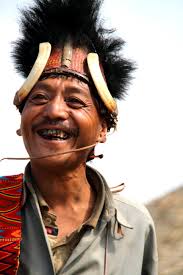|
|

|
|

|
||||||||||||||||||||||
|
||||||||||||||||||||||
|
Naga Tribes Physical Features | Dress & Ornaments | Profession | Houses | Food | Games | Customs |
||||||||||||||||||||||
| The Nagas occupy the northern, north-eastern, and north-western hills of Manipur. The different groups of Nagas are Thangkhuls, Mao, Muram Nagas, Tadubi, Kolya, Khoiras or Mayang Khong, Kabuis, Koirengs, Chirus and Marings. There are several stories about the origin of different groups of Nagas. It is believed that Nagas and Meiteis have common ancestors.  Nagas are of Mongoloid stock. The skin colour varies according to the habitat. The Tangkhuls, Mao-Muran Nagas are generally fairer as compared to the Kabus. The men are muscular and sturdy and full of stamina. The nose is flattened at the nostrils but most of Tangkhuls show some marked sharpness in their Mongoloid features. Height-wise all Naga groups are medium sized. Marings are tall and well built. The women are short but stout. Their eyes are deep set with bulged eye sockets. The nose is slightly flattened at the nostrils and its length is also comparatively short. The lips are thick but some Thangkhul women like their men folk having sharpness in their nose and other features. Women are generally fair in Complexion especially Tangkhul women. Some old men keep their hair long and arranged in tangled knots, but in the present day the fashion is to wear hair up to the ears only. Women grow hair but some prefer bob cuts. The bobbed hair makes the young Naga girl look more beautiful with her ruddy face. Both men and women are very fond of ornaments. They wear a wide range of ornaments. The ear lobes are pierced to make holes at some early stage. Men also wear armlets of brass or other metals. Coiled wire rings and spiral rings of big size are used. The ear-rings are also very big in size. Men wear typical and strong metal ornaments for self defence. Cane or brass rings are also worn below the knees to provide strength in in climbing hills. Men wear necklaces with red stone and any kind of glass or precious stones, beads, metals and cowries. Women wear necklace of polished hexagonal cornelian beads. They wear small ear-rings. Brass and metal armlets are common ornaments of woman. Some wear collarette of blue beads. Wealthy woman wear ivory armlets gals bead necklaces are also preferred. Necklace made of red pebbles is worn only by wealthy gentry. Many woman adorn their upper calves with cane rings and upper arm with a brass ornament made of a thick wire finished into a bell-shaped mouth at both the extremities. The ornaments is worn round tightly crossing the hinder portion of the bell over each other. Tattooing is customary only in remote areas in the North and the East. |
||||||||||||||||||||||